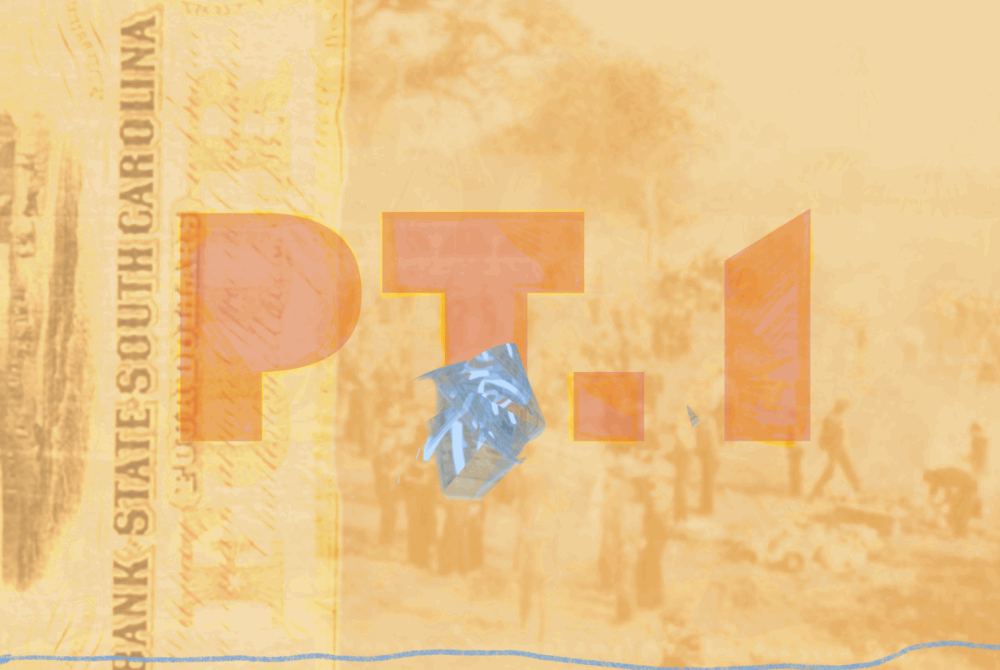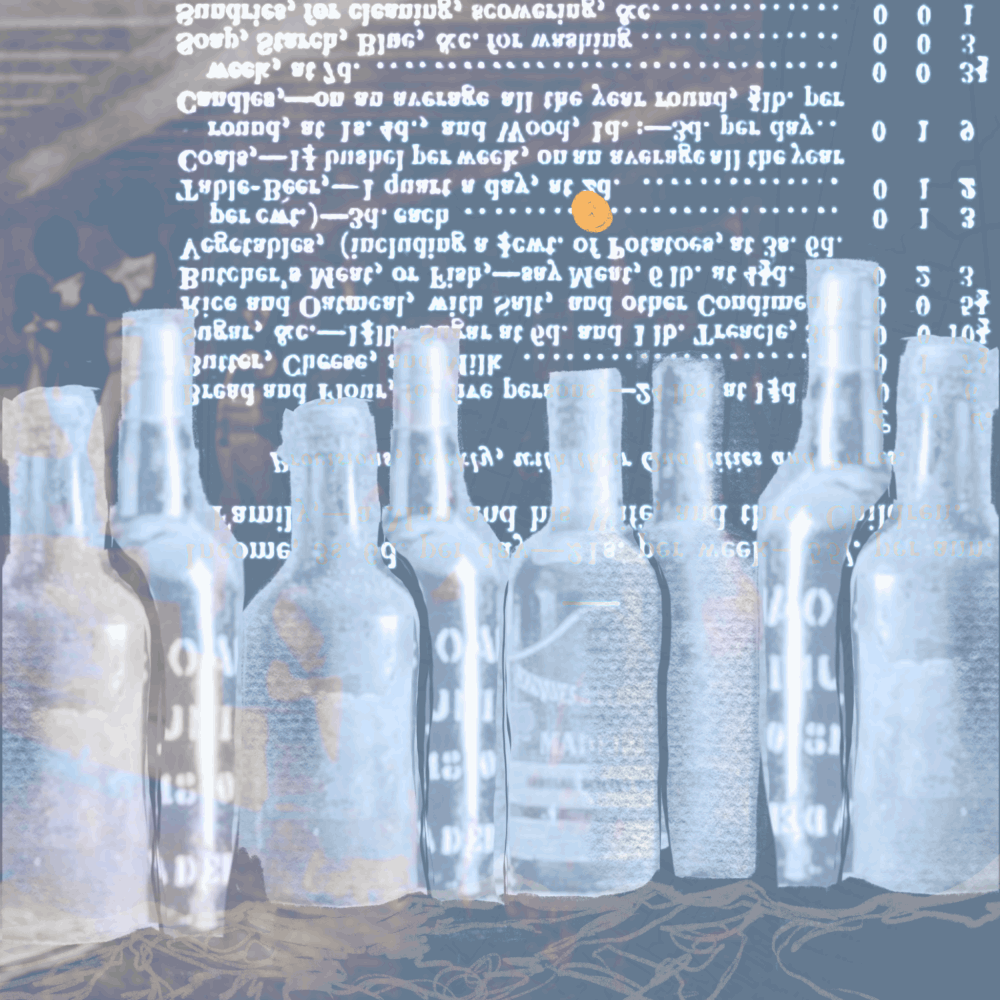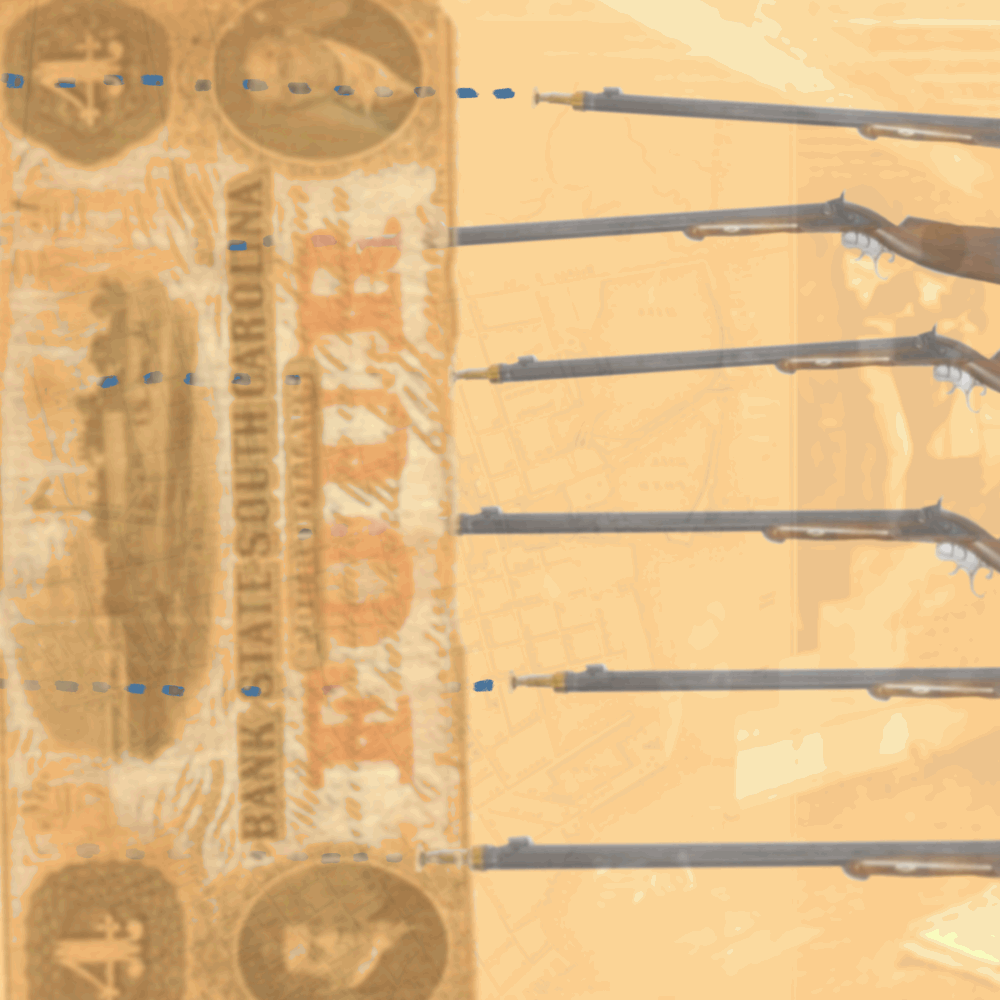
Mus tek cyear uh de root, fa heal de tree is one of many Gullah Geechee proverbs that fell on my ears during my childhood in Charleston, South Carolina. Though most sayings like this are didactic, I didn’t always understand their meaning when I was young. But now, at 42 years of age, I find their wisdom—the importance of taking care of the root before a tree can heal—helps make the ills of the society I inhabit more comprehensible.

Charleston, with its richness of culture and heritage, is often labeled one of America’s best destinations for travel. Still, most guides conveniently ignore the history of enslavement and segregation in the self-styled “Holy City.” That tangled identity is a truth I’ve known since I was a kid, and which I sadly witnessed again on a recent visit home.
Thanks to my enthusiasm for beer and brewing, I’m always excited to check out taprooms and alehouses wherever I go. That weekend was no different. I called one of my buddies, and we linked up at a brewery. Three hours later, we’d popped into three different spots, all within a quarter-mile radius. While standing in line waiting to order another pint, he nudged me and muttered a question: “Where are all the Black people?”
Depending on who you ask, there are two ways to answer that question, though neither gets at the whole truth. Going to breweries is some white-people shit. Alternatively: Black people don’t drink beer.
EDITOR’S NOTE
“Tek Cyear uh de Root” is a three-part series written by Jamaal Lemon—and with additional research and writing by Brian Alberts, Mike Stein, and Peter Jones—exploring the origins and evolution of the 19th-century Charleston Schützenfest. The annual shooting tournament and festival began before the Civil War as a celebration of German culture, but it soon became mired in Charleston’s racial hierarchy and the shifting goalposts of American whiteness. This series investigates the festival as a crucible where white supremacy, Black resistance, the local experience of Reconstruction, and shifting German-American ethnicity all fused together. These stories are also anchored in Charleston’s Gullah Geechee community and traditions, and will show how the early iniquities of the Schützenfest still influence the city’s—and the country’s—beer industry today.
Follow along as we explore this little-known chapter in American history, and tune in to the three-part, companion podcast series, which will be published on Saturday, July 10.
Countless historical events, legal policies, and social barriers have made it so that there weren’t many Black faces at that particular brewery on that day—nor at the two previous. Spend any time in the industry, and you’ll know that craft beer is overwhelmingly white and male. Like the unattended root of a tree, adverse issues continue to persist within the industry, distancing it further from its founding aims. In Charleston, one of the many reasons there are so few faces of color in breweries is homegrown, tracing back some 150 years—though less than a mile away from where we stood that day—to the Schützenfest.
The Charleston Schützenfest, a shooting competition and community festival transplanted from Germany, was held at the German Rifle Club’s grounds on the banks of the Ashley River for decades, starting in the 1850s. While club members took aim at targets and a traditional wooden eagle mounted atop a pole, other visitors enjoyed games of chance and skill, as well as music, dancing, and plenty of food and beer. Men and women, Black and white people, immigrant and native-born visitors were all welcomed under the banner of celebrating German culture—at least at first.
Schützenfests were common across the U.S. during the mid 19th century, one of many stages where German-Americans used their culture to help negotiate both local and national inclusion. Over time, however, the Charleston Schützenfest came to serve as a proxy for South Carolina’s winding path through the Civil War, white supremacy, and the denied potential of Reconstruction. Ironically enough, Black visitors were welcomed at the early Schützenfests, because their relationship with immigrant communities didn’t fit into the binary racial fiction that the slaveholding class maintained. But that would change, as the boundaries of whiteness shifted and promises of racial equality were systematically betrayed.
It’s a vivid story that we’ll tell in three parts, starting in 1855, when there was more drawing Gullah Geechee and German Charlestonians together than pulling them apart. The Schützenfest was nascent and relatively small-scale during this period, but the world it grew from foreshadowed much of what was to come, from the fruits of white supremacy planted in Charleston’s infancy to its modern-day beer scene. The grounds where this festival once took place can be seen as the cradle of Charleston’s contemporary craft beer culture. Though it has a population that is 44% African-American, the Holy City still has no Black-owned breweries today.
GOODS, SERVICES, AND NEGOTIATIONS
Pre-Civil War Charleston was what historians call a slave society, as slavery was so integrated into its politics, economy, and culture that it governed nearly every aspect of life.
The Holy City had a total population of just over 40,000 in 1860. About half were descendants of West Africans, also known as Gullah Geechee people, of whom around 3,600 were free Black residents, while about 17,600 were enslaved and heavily segregated. To add insult to injury, Charleston law assumed any Black person was enslaved unless they could prove otherwise. Any enslaved person in public had to carry a pass with explicit instructions. If a police officer believed they were deviating from the instruction, or they simply didn’t have a pass, they could be arrested or subject to public flogging. Under the slave code, Black Charlestonians could be—and were—barbarically punished for such offenses as carrying canes, wearing top hats in public, smoking cigars, and singing.
Police and white supporters maintained a culture of mistrust toward Black residents and anyone who might support them. A perennial debate in Charleston politics was whether the police force was well-funded enough, large enough, and strict enough on the Black population. White criminals could be sentenced to jail, while Black criminals were sentenced to whippings or workhouses. Displays of power—police and militia parades, imposing guard houses, prisons, and military schools, as well as frequent arrests—acted as a protective shell around the status quo.
Since colonial times, Black vendors, mostly women, had sold produce, eggs, potatoes, and other products near the wharves. Their voices gave Charleston a defining sound that rang out in melodic opposition to the clatter of marching steps and cannon drills. Their sales tactics were zealous and direct, but never random. Vendors incorporated West African modes of negotiation and dialect passed down by their ancestors into Charleston society.
Their distinct culture helped make the city’s markets famous nationwide, though white elites sometimes tried and failed to suppress their influence. Commercial spaces like these were special because the racial hierarchy was weaker there. As historian Ashley Rose Young has noted, the commercial relationships of the marketplace also served to renegotiate authority between enslaver and the enslaved—even if only temporarily, and only in that space.
Free Black Charlestonians worked in skilled trades far more often than their enslaved neighbors. They were carpenters, barbers, cooks, seamstresses, and fishermen. Very few owned businesses, and if they did, seldom for very long—they had virtually no access to credit or capital, and whites would never patronize their enterprises anyway. The enslaved were mostly restricted to unskilled and domestic labor, and often “hired out” (essentially rented) to work for other whites. Once hired, they wore metal badges marking their condition, a practice unique to Charleston, and poor white laborers occasionally asked the government to ban the practice of hiring out so they wouldn’t have to compete with Black slave labor. City leaders, overwhelmingly from the slaveholding class, always refused.
GERMANS IN THE HOLY CITY
German immigrants made up under 5% of the city’s population in 1860, or about 9% of its “white” population. That percentage slowly declined over time as local population growth outpaced incoming immigration. (Immigrants were rarely considered white themselves, except in cases where portraying them as white helped persecute a Black person.)
Many, along with some Irish immigrants, earned their livings as wholesalers and grocers, particularly in poorer and ethnically mixed neighborhoods. Frequently, these grocers purchased a building with apartments above their storefronts. Called “Dutch corner shops” (the term ‘Dutch’ referred to anyone who spoke a Germanic language at this time), these German grocery stores often doubled as saloons by adding barrooms to sell cigars, liquor, and beer shipped from Northern cities, as Charleston had no breweries of its own at the time. These shops became quite controversial among the slaveholding class, because they relied not just on alcohol sales to stay afloat, but also upon a Black clientele. They functioned as a space where Black consumers sought to carve out their own drinking culture, as a way to avoid and resist their oppression—as if to feel free, if only for the brief time it took to have a drink.
Consumer relationships, combined with cohabitation and shared discrimination from white elites, forged a closer social relationship between the poor German and Gullah Geechee communities that would soon shape the Schützenfest. It wasn’t harmonious—it was capitalistic, uneven, and at times contentious. It also stood apart from the city’s blatant, unreserved commitment to white supremacy.
These grocery stores also contributed to a broader relationship between the two groups. Many Germans clustered in the same northern and western wards of Charleston as the city’s Black residents. They shared streets and homes with their Black neighbors. German boarders sometimes rented a room from working-class Black families, and vice versa. Usually this was a platonic arrangement, but a few Charlestonians with one Black and one German parent do show up in later census rolls.
When immigrants, mainly German and Irish, first arrived in the United States, they soon found themselves swept up in this cycle of white supremacy and the persecution of Blackness. Nativism, or anti-immigrant sentiment, was rampant. But not all German immigrants engaged with Charleston’s slave society in the same way. Some subverted it, like Jacob Reils, a grocer who risked the death penalty by harboring fugitive slaves. Others bought in, like Charles Werner, who used enslaved labor to build a thriving iron foundry in the city, then used the profits from that to build the “Iron Palace,” an extravagant concert hall and Lager beer saloon. In its day, Werner’s palace probably did more to proselytize German-style Lager beer in white Charleston than any grocery store, because his approach embraced white supremacy and racial segregation.

Variations in immigrant behavior were usually generational. Older immigrants who’d arrived before the pro-democratic Revolutions of 1848 in Germany were richer, more politically conservative, and more vested in the slave society they found. They more often endorsed racial hierarchy and sought favor from white elites. Younger, newly arrived immigrants had witnessed, and often participated in, a revolutionary Germany which promoted cultural pluralism over aristocracy. They were less eager to assimilate and often bucked the status quo of their adopted home, including slavery and liquor laws, because they believed a society should grow to incorporate new communities. They were also poorer, and owned most of the small-time shops that welcomed Black patrons out of financial necessity, politics, or, most likely, both. Save for a few exceptions, they weren’t heroes or activists. Their ideology served them as immigrant outsiders in a new home and, when it came to beer culture, rationalized a little subversion here and there to make a buck.
Consumer relationships, combined with cohabitation and shared discrimination from white elites, forged a closer social relationship between the poor German and Gullah Geechee communities that would soon shape the Schützenfest. It wasn’t harmonious—it was capitalistic, uneven, and at times contentious. It also stood apart from the city’s blatant, unreserved commitment to white supremacy.
And it was growing. The sight of one or more Black Charlestonians outside an immigrant grocery store soon carried a well-known connotation. Police and onlookers spotted an enslaved Black person drinking a mug of beer, a gill (meaning a quarter-pint) of whiskey, or a tumbler of brandy with increasing regularity, and arrests for trumped-up “loitering,” public drunkenness, or rioting charges rose through the 1850s.
NATIVISM AND GROCERY STORES
As sites of beer consumption, places like the Iron Palace, groceries, and the Schützenfest were local engines of a national shift in beer culture. But that shift was politicized, contested, and racialized, especially in Charleston. Trading with the enslaved was illegal and subversive, not only in the name of racial hierarchy but also because enslaved African-Americans tended to pay for their goods with items stolen from slaveholders. Additionally, Germans tended to oppose restrictive liquor laws of any kind. As such, Black drinking at German groceries became a huge local issue throughout the 1850s.

The practice tended “to undermine the institution of slavery,” as Charleston’s mayor William Porcher Miles declared in 1857. A city judge, when sentencing an Irish shopkeeper in 1858, deemed it “essential” that “the interests of the slaveholding people should be maintained against any foreigners.” And he all but threatened vigilante terrorism if they weren’t, saying, “If the delivery and sale of liquor to slaves was to be carried on constantly, there was no telling how many fires and murders and thefts would be the consequence.”
Though it never came to that, historian Jeff Strickland has shown that Germans were hauled into court by the hundreds throughout the 1850s—at least 35 just in January 1854, another 40 in May and June of 1855, and more as time went on. If “loitering” was the only charge the city could make stick, these grocers typically faced a $20 fine, a substantial sum at the time. The longer the issue persisted, the more politicized it became. The late 1850s saw crackdowns, higher fines, and jail sentences.
In May of 1856 alone, 18 German grocery stores were fined for opening on Sunday, and 32 for operating without a license. Grappling with local liquor laws was a common sight in Northern cities, too—defending their beer culture was part of German-Americans’ broader pursuit of citizenship, prosperity, and ethnocultural acceptance. Black Charlestonians at these shops, free or enslaved, were regularly arrested on public drunkenness or “rioting” charges. They typically faced a fine of $3 to $5, whipping at the city’s workhouse, or up to a week of solitary imprisonment. The German and Gullah Geechee relations were viewed by Southern whites as a threat to the slave system, an imperfect merger that made it harder to maintain white supremacy.
The grocery store issue also stood in the way of Germans being considered white. European immigrants were “supposed” to be on the side of whiteness, slavery, and the belief in racial hierarchy. Until then, their own racial status was murky. Some white Charlestonians undoubtedly patronized German grocery stores. Some attended the early Schützenfests too. But doing so opened them up to criticism from nativists saying that “clanish and tribal” Germans would “try to make a Dutchman of him,” the derision being that the German was not fully white, and therefore not worthy of the established racial hierarchy.
A city judge, when sentencing an Irish shopkeeper in 1858, deemed it ‘essential’ that ‘the interests of the slaveholding people should be maintained against any foreigners.’ And he all but threatened vigilante terrorism if they weren’t, saying, ‘If the delivery and sale of liquor to slaves was to be carried on constantly, there was no telling how many fires and murders and thefts would be the consequence.’
Charleston’s Schützenfest tradition began during these years, occupying the same rocky middle ground as its German-American organizers. Though Germans retained exclusive access to the shooting tournaments, their Black neighbors were welcome visitors at the festival and took particular advantage of its games, such as climbing a greased wooden pole to claim prizes at the top. White Charlestonians attended, but their observations were detached and bemused. They found the dancing charming and the games silly, but they regarded the shooting tournaments with sincere respect. As a niche, curious event on the outskirts of town, it drew less white supremacist ire than the marketplace and the groceries, but it nevertheless offered one more space where racial lines might concievably blur. And just 10 years later, this same fest would inhabit an entirely different world.
A SEA CHANGE
Tensions over the grocery store issue, like the rot of the slave society surrounding it, were not resolved by time, civil discourse, or law, but rather by war. In April 1861, Confederate soldiers fired on Fort Sumter and started a war that would change Charleston and the nation forever. There was apparently no Schützenfest that year—the German Rifle Club’s shooting grounds, called the Schützenplatz, were being used to organize and train Confederate Army units.
For the most part, Germans in Charleston were pretty ambivalent toward the Confederate cause. Even so, military service or other support for the war was more or less required if they were to maintain any status in the community. Most volunteered for local militia service that allowed them to remain close to home. Immigrant Unionists who opposed the war could only express their opposition indirectly, such as providing cigars, food, and other comforts to Union prisoners of war who were brought to the city. As we’ll see in Parts Two and Three, Black Charlestonians would support the Union cause far more vociferously than their German neighbors once the slave system crumbled.
Some Charleston whites undoubtedly patronized German grocery stores. Some attended the early Schützenfests too. But doing so opened them up to criticism from nativists saying that ‘clanish and tribal’ Germans would ‘try to make a Dutchman of him,’ the derision being that the German was not fully white, and therefore not worthy of the established racial hierarchy.
German Charlestonians’ mixed support for the Confederacy would ultimately morph into a much stauncher support for white supremacy as their economic fortunes, ethno-nationalist outlook, and outsider status all shifted after the war. The Schützenfest is a colorful and integral piece of that story.
For now, let’s recall some familiar refrains in craft beer today: Women prefer wine; Black people just don’t like beer; going to breweries is some white-people shit. They sound simple, obvious, and timeless, and that’s part of their power, because any proposed work to change them therefore sounds massive and intrusive. But when we investigate just how much deliberate work goes into creating and normalizing exclusion—into maintaining social barriers for so long that it feels like they were always there—we can see that the disruptive might actually be a corrective.
The ugly truth behind feeding a society centuries of these assumptions is generations left with warped perceptions. Without the complex, nuanced truth, we’re all guilty of prejudging what we see in the here and now, and not taking proper care of society’s roots.
The result: prejudices that grow and feed on our communities, like Spanish moss on live oaks.
Up next: Read Tek Cyear uh de Root, Part Two — The Deliberate Reconstruction of the Charleston Schützenfest

 Words by Jamaal LemonIllustrations by Colette Holston
Words by Jamaal LemonIllustrations by Colette Holston
Language 
